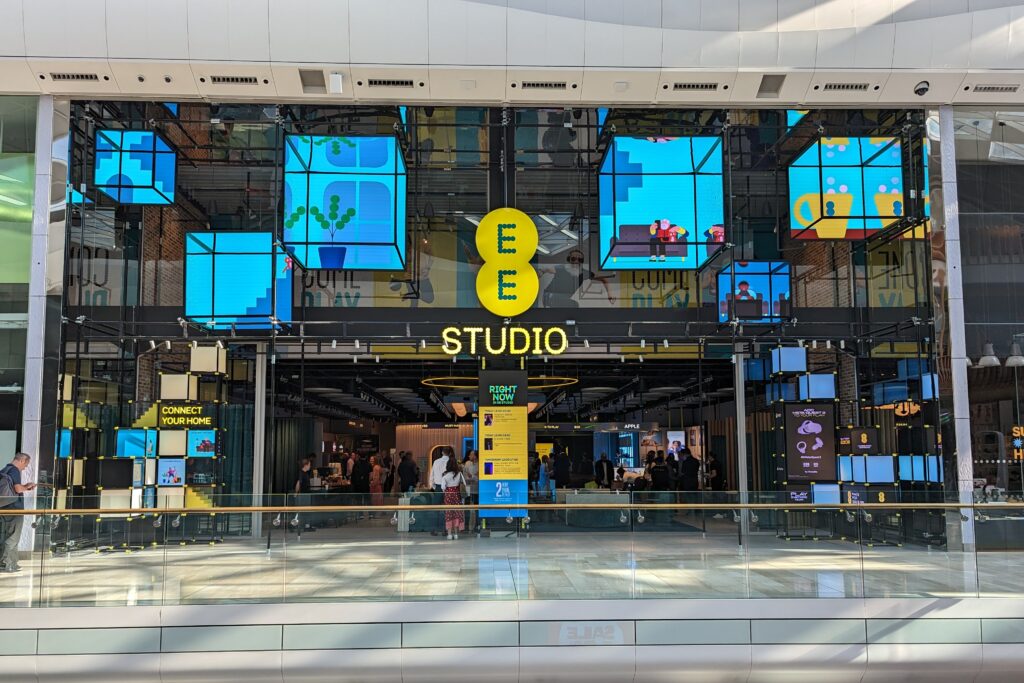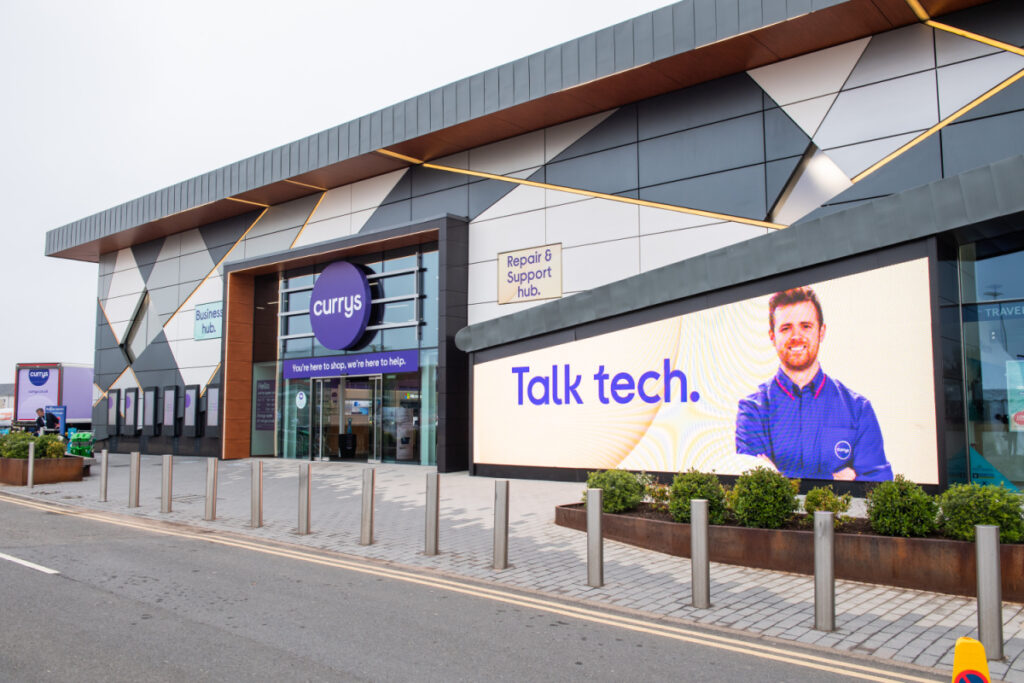Just a decade ago, high streets and malls were awash with mobile phone shops with a seemingly endless number of places to peruse the latest Blackberry or Samsung Galaxy.
Those stores are far fewer in numbers. Phones4U collapsed into administration in 2014 and Currys-owned Carphone Warehouse closed all its standalone stores in 2020.
In fact, the number of high street phone shops has plummeted 38% over the past five years, dropping from just over 10,000 in 2017 to just over 6,000 in 2023, data from the Local Data Company shows.
That’s not to say the mobile phone shop is dead. A new breed of concept phone store are popping up in a bid to rival tech giants Apple and Samsung.
Telco giant EE is in the middle of a UK-wide rollout of experience-led flagship stores – a new take on the traditional mobile phone shop focusing on home connectivity and services.
It’s not the only telecoms giant that’s dived into a new format, as Three rolled out a series of ‘Lifestyle’ stores in Ireland as part of a €27m investment back in 2021.
As telco retailers look to become more experience-led, is this the end of the phone shop as we know it?
EE’s new store on the block
EE debuted its experience-focused flagship inside London’s Westfield White City back last month, marking a new chapter for the phone shop.
The 4,230 sq ft space, dubbed the EE Studio, features a gaming zone, a lounge area offering complimentary tea and coffee, a digital spa inviting consumers to relax in an immersive sensory room.
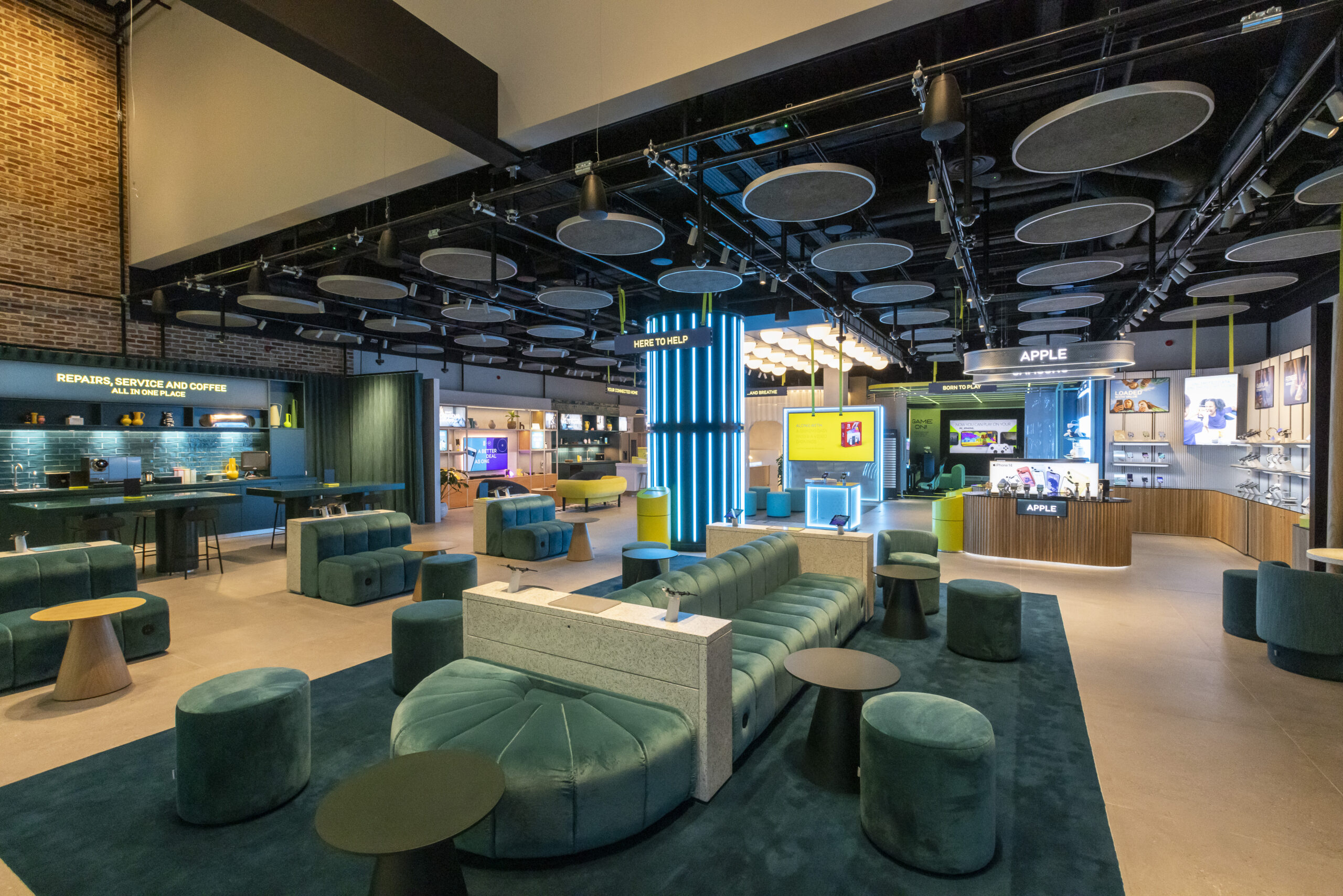
There is also space for product workshops, as well as home room sets to demonstrate the increasing link between phones and household appliances.
According to managing director of commercial Bridget Lea, the format welcomes in “a new EE” focusing on “fulfilling all our consumer tech needs”.
The gaming zones, lounge area and product workshops will be replicated across three other flagship stores that will open this summer in Cardiff, Manchester’s Trafford Centre and Bluewater.
“It’s completely different to other telco and tech flagship stores,” says Lea, referencing the natural clean aesthetic of Apple and Samsung.
“If you look at some of the things we’ve got – the gaming, the digital spa, the home experience, the free coffees – no one else has got any of that.
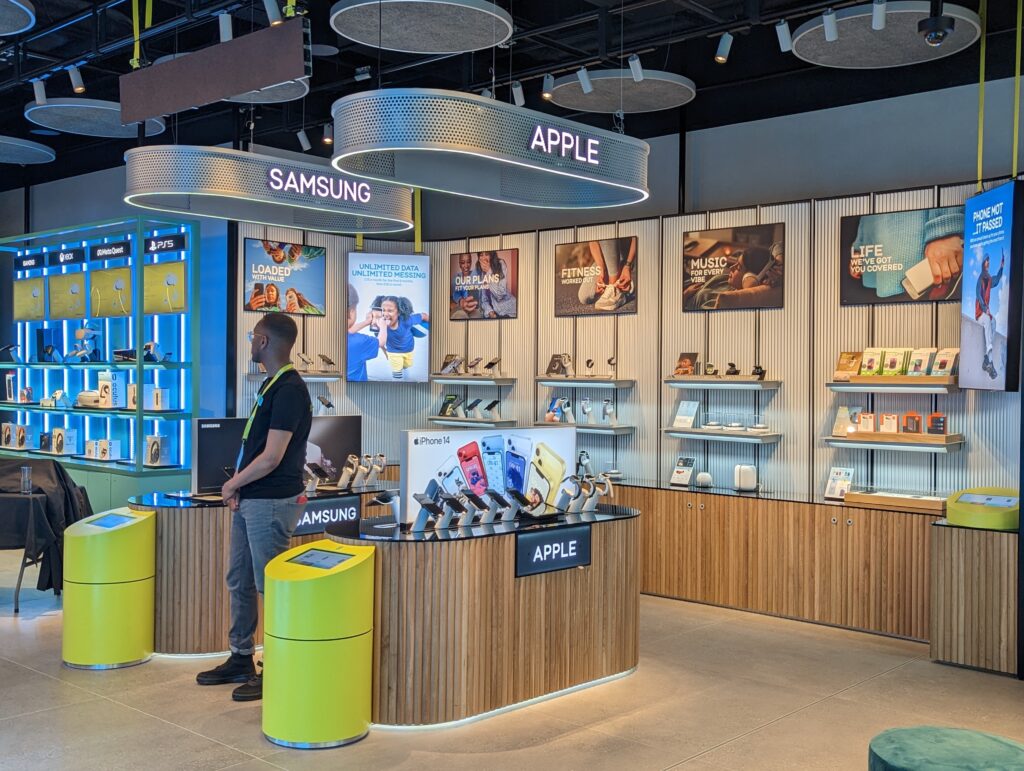 “We wanted to create something that felt like EE and not like a version of the Apple store,” she says, explaining that mobile networks have typically drifted in the direction of adopting Apple’s white minimalist aesthetic when updating their store fit-outs.
“We wanted to create something that felt like EE and not like a version of the Apple store,” she says, explaining that mobile networks have typically drifted in the direction of adopting Apple’s white minimalist aesthetic when updating their store fit-outs.
“There’s an energy to this space,” she adds, referencing the bold pops of blue and yellow around the shop floor.
Alongside the roll-out of the tech-driven experience stores, EE is also revamping the rest of its store estate.
Lea says: “I expect over the coming months that little pieces of [EE studio] will start to emerge in our smaller stores.”
How phone shops are becoming more relevant
Telco retail in the past has predominantly focused on mobile connectivity selling phone contracts and handsets, however, it seems the next chapter is extending to home connectivity.
“We’re stepping into a new space,” explains Samsung omnichannel and marketing director Annika Bizon.
“What you’re seeing through the likes of EE [and the Studio concept] is that everyone wants to own that connected space.”
“It’s not to say you’re not going to have standard mobile phone shops, but you’re going to have a mix of how we own the connected home,” she adds.
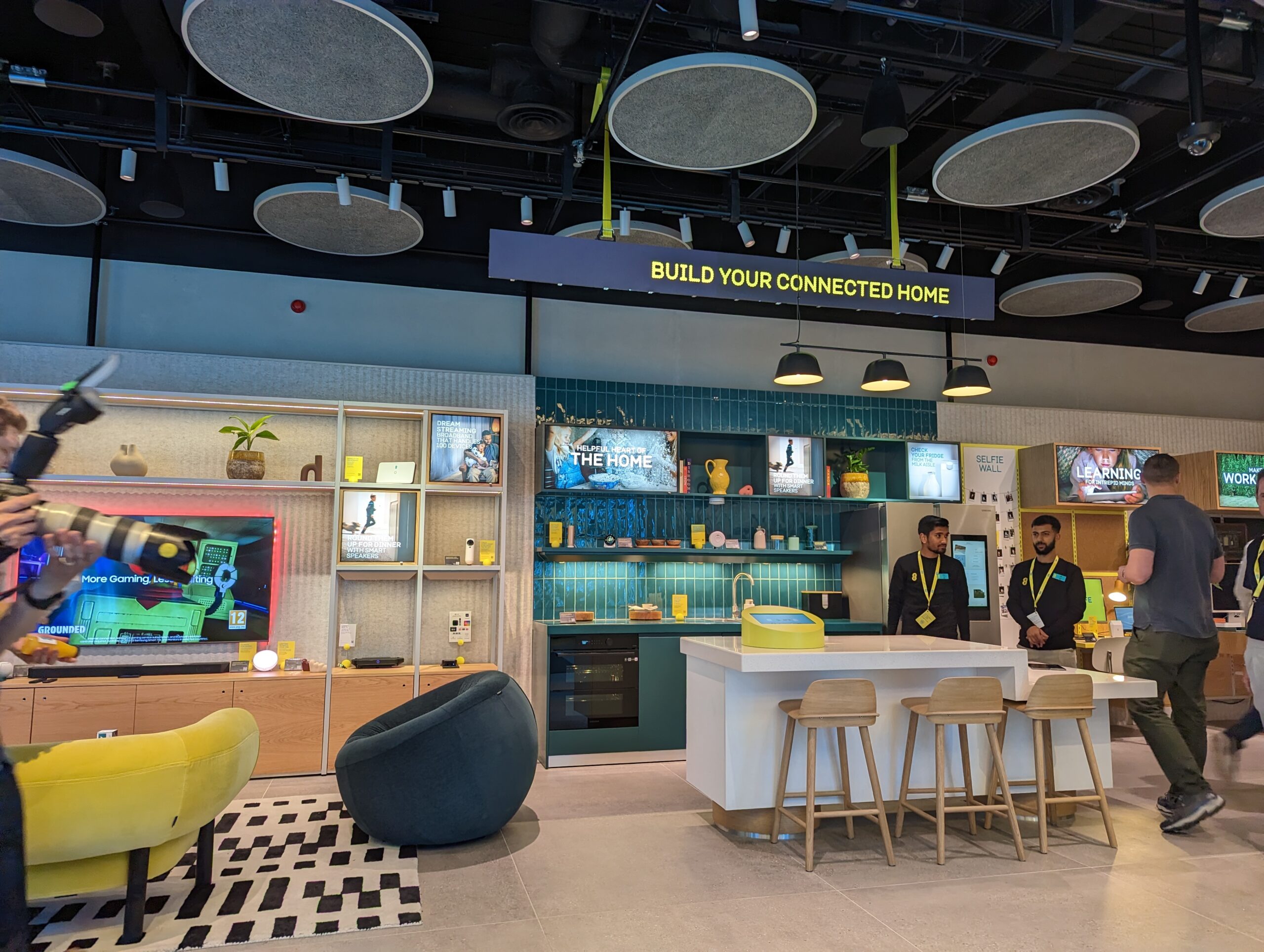
Samsung has dabbled in this through its Experience stores and KX flagship, which offers the latest Galaxy models alongside a series of smart home appliances – such as fridges, ovens and washing machines – that can link up to a phone app.
However, according to Lea, the connected home concept is still an untapped market on a local level.
“We all need the sector to raise the bar, and tech is such a massive part of everyone’s life but I don’t think it’s represented as well as it could be on the high street,” she says.
“We have to think outside the box, broader than selling a mobile phone, and help customers address all of their tech and digital needs,” says Lea.
“Hopefully, we’ve shown that we’ve put a marker in the sand to say this is what we believe the future looks like and what we shall be doing right now for our customers.”
Three director of sales Ronan Gibney adds that thanks to the rise of omnichannel, customer expectations have risen.
“Shoppers have high expectations as they are accustomed to engaging in all channels within a retail organisation,” he says.
The push has encouraged Three to ensure the customer experience is connected “whether they engage with us on our app, the contact centre, our website, or in our stores”.
The changing landscape of phone shops
Walking down the local town centre 10 years ago, phone shops packed with shoppers were everywhere.
Stocked with the latest models and offering a multitude of contracts, the distinction between each one was down to what network you wanted to be connected to and whether you wanted a package deal or to buy the phone outright.
The market has since seen a lot of consolidation from its peak, with Orange merging with T-Mobile to become EE in 2012, and the recent deal between Virgin Media and O2 resulting in the closure of Virgin Media stores as O2 becomes the consumer-facing brand.
The decline of mobile phone specific shops from the high street over the years has been met with technology shops – such as Apple and Samsung – expanding their own retail offer.
Meanwhile, the growth in online meant that loyalty to the phone shop started to dwindle.
It drifted even further way when providers started pushing SIM-only contracts.
“Buying a phone outright is a really big part of the market because all the operators have pushed SIM-only contracts,” says Bizon.
“You don’t necessarily buy into your package, so what you are seeing is that retailers that probably weren’t mobile phones shops in the past are now really getting into that space.”
Department store John Lewis expanded into phones in 2015, selling the latest handsets and phone contracts as it looked to grab a share of the market. Meanwhile, supermarkets including Tesco and Sainsbury’s have long had a stake in the market.
Consumers are also buying more second hand mobiles through traditional retailers like Apple or dedicated online websites such as Music Magpie or Cex.
In fact, a study by Vodafone found that 32% of Brits now own a refurbished phone, with a 24% looking to get their hands on one.
Is the physical phone shop still needed?
The simple answer is yes, according to Three’s Gibney, who says its stores are “absolutely still a necessity” for customers.
“Our experience of Covid has shown us how important human contact is and the role our people play in store is crucial to our success,” he says.
So, what does the future phone shop look like?
“You’re going to have your standard mobile phone shops, and they will be adapted slightly, and you’re going to have a new influx of more connected spaces explaining the customer journey,” says Bizon.
“You may see mobile phone shops – just like you have with EE – start to talk about fridges, start to talk about things that you’ve never expected to talk about.”
Similarly, Lea points out: “It’s not just been about the mobile phone for many, many years.
“Our homes are getting smarter and our lives are becoming more connected and as customers, more sophisticated.
“There’s an opportunity in our sector for us to help customers with that,” she adds.
Stores like EE’s new Studio and Three’s Lifestyle stores could just be the marker in the sand the sector needs to inspire customers.
Click here to sign up to Retail Gazette‘s free daily email newsletter

